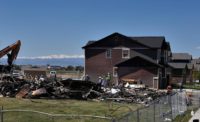After weeks of harrowing rockfall work, one lane of U.S. 550 in southwestern Colorado is open to traffic on a limited basis. A massive rockslide closed the remote highway on Jan. 13. The rugged, two-lane road, also known as the Million Dollar Highway, winds over 11,018-ft-high Red Mountain Pass between the small towns of Silverton and Ouray.
The closure came when a section of rock the size of a football field sheared away from a towering cliff known as the Ruby Walls and sent 7,000 to 10,000 cu yd of debris onto the highway 900 ft below. Boulders punched holes in the roadway and created a slide zone 200 ft long and 8 ft deep.
“It was a significant rockfall event, one of the biggest in CDOT history,” says Bob Group, an engineer and geologist and the rockfall program manager for the Colorado Dept. of Transportation.
No one was hurt in the slide and no property was damaged, but it blocked access to the pass for the 2,200 vehicles a day that use the narrow road. As one of only two ways in and out of the town, the slide forced Silverton residents into a five-hour detour through the rugged San Juan Mountains, effectively cutting the area off from the outside world.
“We do not have easy alternate routes here in southwest Colorado, and there is a hardship any time we close this pass,” says CDOT Region 5 Transportation Director Kerrie Neet.
CDOT has battled rockslides on its mountain highways many times in the past, but the real story of the Ruby Walls slide is the unusual plan for mitigating the rocks that continued to fall hourly onto the highway from the disintegrating talus slope above.
CDOT engineers needed to assess the debris field but getting up to it from the roadway was dangerous and difficult. So for the first time in its history, CDOT called in technical climbers to help the agency’s crews reach the slope safely from above the slide area. “This is a first for us, bringing in technical climbers like this on a major slide,” says Ty Ortiz, CDOT’s geotechnical program manager.
Mountain climbing specialists from Ouray’s Rigging for Rescue rappelled down the cliff, and others were helicoptered onto the mountain with CDOT engineers in a “high-risk, toe-in landing on a 25-degree slope that brought the chopper’s blades precariously close to the rocks,” says Mike Gibbs, owner of Rigging for Rescue.
Gibbs and his crew created a 300-ft-long “safe rope-access pathway” across the top of the debris field and nearly 900 ft above the highway for site reconnaissance and scaling of larger rocks, which they did by hand using five-ft pry bars.
On Jan. 22, before rock crews were on the mountain, CDOT’s helicopter contractor, Silverton Mountain, dropped ten 30-lb bombs onto the talus slope to loosen larger rocks and stabilize the debris field. Then, working alongside CDOT engineers, rock specialists from contractor Yenter Cos., Denver, drilled 1.25-in. vertical holes across the slope and epoxied into place a series of #10 steel bars to anchor the rock nets that would hold the talus slope back.
Containment work on the slippery talus field in the cold mountain winds was made more dangerous by ongoing rockfall from the unstable cliff above. The 12-man crew included two rock spotters positioned above the work zone. They kept an eye on the wall and used airhorns to warn the team about rocks coming toward them along the 400-ft sheer face.
“The entire time up there along the cliff, you felt hunted,” Gibbs says. “The [rockfall] hazard never went away. It was only the guys with the airhorns that kept us safe.”
“We had some close calls,” Group adds. “But the ropes allowed us to move sideways pretty quickly and get out of the way. Thankfully, no one got hurt.”
Over the next several days, crews covered the talus slope with 30,000 sq ft of wire netting. The 36 panels, each weighing 600 lb, were brought to the slope by helicopter, which hovered above the site, then backed slowly down the mountain to unfurl the nets.
On the mountain below, crews secured the 12-ft by 72-ft panels to the steel anchors and shackled them together—eight panels across and four down the slope, eventually stretching across 85% - 90% of the debris field to keep it in place. Gibbs says the crews worked nearly 1,000 man-hours on the mountain with no injuries.
All of the nets were secured by the first of February, when a major winter storm moved into the area, dumping nearly two ft of snow on the pass, and stopping work on the mountain. Roadway crews have since erected a rock barrier along part of the roadway itself, allowing one lane of traffic through the slide zone at signalized intervals.
Group says the next stage is to move the rock barrier off the highway and onto the slope, eventually restoring two-way traffic. But more permanent solutions to the slide chutes below the Ruby Walls will take more time and ingenuity, he says.













Post a comment to this article
Report Abusive Comment